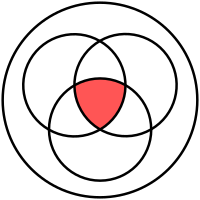
With the Christmas season upon us and the celebration of the birth of Jesus, I thought it was appropriate to consider how the season draws people closer to one another. It seems only natural to quote the verse in Luke 2:14 (KJV) “Glory to God in the highest, and on earth peace, good will toward men.”
So you are probably wondering what the three circle overlap symbol is for. In mathematics it is a Venn diagram (conceived by John Venn in 1880) with three sets that overlap their common elements. The middle portion is what is known as the union of the elements.
Recently I was listening to a politician talk about using common ground instead of compromise. I thought of how slick of a marketing tool that was. No one wants to be seen as compromising their beliefs. Then it dawned on me that it’s more than slick, it’s true and acceptable to everyone. Common ground is the safest and most agreeable starting point to find peace. Who doesn’t want peace?
What’s brilliant about common ground is that it’s a win/win for both parties involved. You may think it is compromise in disguise, but the definitions are different. A compromise is “a settlement of differences by mutual concession.” Whereas, common ground is a “foundation of common interest.” When you compromise, you give up something. However, when you find common ground, you agree on a mutual foundation of what you both want. I prefer to use the term intersect “to have one or more points in common,” because it doesn’t get misinterpreted with compromise and still is equated as the union of the broader elements.
An example of compromise was when a piece of recent legislation was to allow the Bush tax rates to stay in place. The Democrats wanted an increase for the rich and the Republicans wanted it to stay the same. In the end, just before the Christmas break, the tax rates were allowed to stay in place with an extension for the unemployed added. This is compromise. It’s a compromise because everyone got something they wanted, but everyone also got what they didn’t want. A better solution would have been the common ground or intersect, which was to have taxes stay the same for the middle class and poor—no more no less. All democrats and republicans agreed on that issue, because it was the key element of the bill. If the intersect of the bill was enacted, both parties would have had what they wanted, good will would have resulted, and they could have turned to other issues that both agree on; or if time permitted, try to persuade the other party to broaden the circles of their ideas for future legislation.
I contend that my idea of an intersection of ideas rates higher than the status quo. Look at the polls for congress. As of December, 2010, congress has an average approval rating of 19.4 %. If a company had an approval rating that low, it would be a matter of time (very short time) before they would go out of business.
Franklin D. Roosevelt once said that “Under our democracy, one party always devotes its chief energies to trying to prove that the other party is unfit to rule; both commonly succeed, and both are ultimately right." Is that the kind of common ground we want? I think none of us want that. Politicians could accomplish great things as long as they find the intersection between their ideas, but only if they let go of their rigid boundaries and also if they remember they are there to serve the American people.
Some people like confrontation, like to be right all the time, like to cause trouble. But even they have a common thread you could weave into your life circle. The greatest casualties in world history have come from differences over religion. Well here are some quotes that prove that even differing religious thoughts have an intersection or common ground.
New Testament, Paul in Romans 14:19. “Let us therefore make every effort to do what leads to peace and to mutual edification.
Old Testament, Proverbs 17:1. “Better a dry crust eaten in peace than a house filled with feasting--and conflict.”
Koran, Sura 8:61 “But if the enemy incline towards peace, do thus (also) incline towards peace, and trust in God…”
Hindi, Sri Ramakrishna. “The man who works for others, without any selfish motive, really does good to himself.”
Buddha. “Better than a thousand hollow words, is one word that brings peace.”
These quotes represent how peoples from all walks of life search for an intersection for which to find common ground. We may not all believe in the baby Jesus as God sacrificing his cushy life in heaven to be born a human for our salvation. However, all people from all corners of the earth want to be loved by someone, want to share love with others, and have as the angels on high said, “peace and good will toward men.”
It may seem naïve to think simple methods could accomplish great things. It may seem simple that small changes could have great impact. One baby in a manger couldn’t possibly change the dynamics of a society and then a world—and yet He did. I have found throughout my life that achieving great things doesn’t come from taking one giant leap, but rather many small steps. As Christmas passes, the New Year follows. This gives us an opportunity to begin again with a new frame of mind; one that embraces the union, intersection, or common ground, with others to achieve things great and wonderful.


